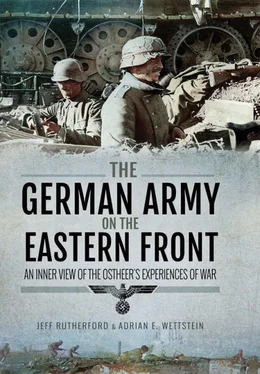The most prestigious group of commanders in the German army were the Panzer leaders, both during the war and in historiography. While the men of the Blitzkrieg phase were well known, in their shadow grew up their successors, dominating higher army field commands and Panzer commands in the second half of the war.
One of these under-researched men was Traugott Herr, whose career culminated in leading the Tenth Army in Italy in 1945. [25]Born in 1890, he became an infantry officer before the First World War, in which he served both at the front and in staffs, exclusively on the Western Front. He was then taken into the Reichswehr and in late 1925, he took several training courses in the newly formed motorized troops, which were at this time merely termed ‘logistical units’ for camouflage purposes. As was usual in the different versions of the German army that existed before 1933, his rise was slow. When Hitler started his campaign to become Germany’s Führer in 1933, Herr was still – at the age of 43 – a Hauptmann . The hasty and massive expansion of the German armed forces in the years that followed was a driver for his career (and those of most German officers). He rose to Oberst before the war, led both a battalion and a regiment and served as tactics instructor at the officers’ academy ( Kriegsschule ) in Dresden. In France in 1940, he led the 13th Motorized Infantry Division’s 66th Rifle Regiment, receiving the Iron Cross 1st Class. When the division was transformed into a Panzer division in October 1940, Herr received command of the newly formed Rifle Brigade 13, a command staff for both rifle regiments. He distinguished himself in the battle for Dnipropetrovsk in August and September 1941, with an independent decision to create a bridgehead over the Dnieper, for which he received the Knight’s Cross. When the division commander was ordered into the Leader Reserve of the OKH in November 1941, Herr was commissioned to lead the 13th Panzer Division. His superiors, General der Infanterie Gustav von Wietersheim and Generaloberst Ewald von Kleist, both proven Panzer leaders, proposed an earlier promotion in March 1942 to make him full leader of the division. On 1 April 1942, Herr was promoted to Generalmajor . The evaluation by von Wietersheim reads as follows:
Valuable leader personality. Clear and resolute. Very good brigade commander. Leads confidently and deliberately. Commits himself personally. He has proven himself particularly successful in the same way as divisional leader during the current heavy defensive battles. Fills this position very well.
A few months later, in mid-1942, General der Panzertruppen Friedrich Kirchner, commander of LVIIth Panzer Corps, to which Herr’s division was attached, evaluated Herr in the following words: ‘Possesses good tactical and operational understanding; energetic leader, clear and purposeful, is optimistic at all times.’
In the fighting north of the Caucasus, Herr drove over a mine on 25 September 1942. This interrupted his career, as a screw penetrated his skull. He also suffered from jaundice, probably a souvenir from his deployment in the Caucasus. When he was again ready for field operations in mid-June 1943, the preparations for Operation Citadel were already completed and all command positions filled. Due to the loss of the Axis position in North Africa and the danger of an Allied landing in Italy, the Germans moved troops to the south and were in need of commanders. Herr, now General der Panzertruppen , would lead the LXXVIth Panzer Corps there for the remainder of 1943 and 1944, before rising to Army commander as mentioned above. This saved him from Soviet captivity.
Herr’s career was typical for professional soldiers in speed and scope. He profited from solid training and enough time between promotions to fully master the demands of each step. The evaluations of Herr also give examples of the qualities demanded by the German military: tactical understanding, determination, strength of will and confident leadership. By late 1942, National Socialist attitudes became part of the leadership criteria and these ideas were later too often attached to able leaders even without them being convinced National Socialists. One should keep in mind that many German soldiers’ primary virtues of the time were congruent with National Socialist values, such as courage, aggressiveness, determination and so on. [26]
Karl von Oven [27]witnessed a somewhat different, maybe even more ‘normal’ Eastern front career. Born in 1888, he entered the army in 1908 as a Fähnrich with the Prussian Guards. He also saw service exclusively on the Western Front in the First World War, serving in the IIIrd Army Corps staff for a long period of time (possibly with Herr, who was also in this unit in late 1916/early 1917) and finally rising to the rank of Hauptmann . After the war, he left the army and entered police service in Prussia, where amongst other tasks he trained police officers and wrote manuals for police deployment during riots in cities. The great need for officers due to German rearmament led to a transfer of no fewer than 2,500 police officers in 1935 to the German Army (a massive impact on the officer corps considering that the Reichswehr only had a total of 4,000 officers). He was released as an Oberst from the police, but the army categorized him only as Oberstleutnant . In October 1935, he was promoted to Oberst . Until the beginning of the Second World War, he commanded a battalion and a regiment, which allowed him to strengthen his command abilities. Promoted to Generalmajor in June 1939, he did not receive a divisional command until May 1940, and then only for the briefly existing third class 393rd Infantry Division. After several short service periods, von Oven was commissioned as commander of the 56th Infantry Division in November 1940. He would lead this division for the next two years in the campaign in the Soviet Union, first advancing with Sixth Army on Kiev, then being transferred to Army Group Centre, where the division was deployed in different sectors during late 1941 and 1942. An assessment by his superiors from spring 1942 reads as follows:
5.4.42, [ General der Infanterie Erich-Heinrich] Clössner [Commander LIIIrd Army Corps]: Character difficult to judge. Very ambitious, very sure of himself. Good military talents. Leads division hard, skilfully and flexibly. In difficult situations quiet and confident. Intolerant representation of his view sometimes complicates cooperation with neighbours. Fills his position very well.
[ Generaloberst Rudolf] Schmidt [Commander Second Army]: Very energetic, as a subordinate, [his] personality is not easy to take. Fully proven as a division commander even in the most difficult situations. Commanding General
5.5.42, [ Generalfeldmarschall Günther] von Kluge [Commander Army Group Centre]: Has always been a difficult personality. In the present time, a particularly suitable leader due to his energy and hardness, also as a commanding general.
While all three of von Oven’s superiors praised his military leadership qualities, including hardness, they also agreed on his difficult personality, which made cooperation with him difficult. But it seems that this could be corrected, as his next assessment in January 1943 showed:
18.1.43, [ General der Infanterie Lothar] Rendulic [Commander XXXVth Army Corps]: Active, confident personality, shows purposefulness and firmness. In leadership, can also be hard where the situation requires, good tactical abilities. He is infused with the National Socialist ideology, which he also represents. Combines the look for the whole picture with the interest for important details. The representation of his intolerant views and the friction with neighbours listed in previous evaluations have never appeared under my command. If these defects have actually existed, they are corrected. Good average. Commanding general of an army corps.
Читать дальше






![John Stieber - Against the Odds - Survival on the Russian Front 1944-1945 [2nd Edition]](/books/405234/john-stieber-against-the-odds-survival-on-the-russian-front-1944-1945-2nd-edition-thumb.webp)





